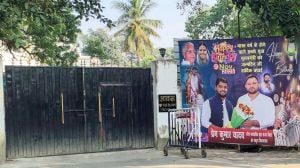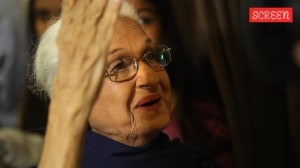People in this district do not remember when they last had a bath
AMRELI, OCTOBER 2: While Gujarat is bracing for another drought, about 50 villages of Amreli district in Saurashtra are yet to get out of ...

AMRELI, OCTOBER 2: While Gujarat is bracing for another drought, about 50 villages of Amreli district in Saurashtra are yet to get out of the last one. For them, it has been a long ordeal which began last November.
For almost a year now, women in these villages have been walking miles to fetch water, tanker supplies have not stopped, and a bath is a luxury. In a state where the rains have been poor, Amreli was particularly unlucky to get just 175 mm of rainfall.
Most of the reservoirs, ponds, checkdams and wells are dry. Taps run for about 15 minutes once in five days. The crops are already dead.
“Nature has played a cruel trick on us,” says Diwaliben Khimabhai of Nava Vaghaniya. She has to trudge two kiometres to bring water from a farm tubewell, balancing three or four pots on her head. Although the government supplies water by tankers, it is always insufficient.
The scene in the main square of Anida village is reminiscent of what was a common sight in Saurashtra last summer. Pots of all sizes are kept there, with children playing around, waiting for a tanker to arrive. No sooner is the sound of the approaching tanker heard than women scramble out from houses and gather around a contraption which has been devised to avoid wastage. It’s a long pipe, closed at one end, with rows of spouts fitted all along its length.
The tanker arrives, its outlet is connected with the pipe bearing spouts, and water begins to flow. Amidst much pushing, jostling and shouting, the pots are filled up. Somebody tries to break the queue and all hell breaks loose.
“It could get worse,” says 80-year-old Dadubhai Dhulabhai, who sits closeby. It’s an orthodox society and the women are supposed to be restrained in the presence of elders. So men like Dadubhai make it a point to reach the village square before the tanker arrives. “We go there in the morning and return only in the afternoon; there are always long queues over there”, says Madhuben Pansara, who managed to fill two big pots before the tanker became empty.
The village has a population of 4,000 and it gets two tankers daily, which means only about 10,000 litres. It isn’t sufficient, and women have to fetch water from a tubewell at Surya Pratapgarh, about 3 km away.
Water supply by tankers was first started in Anida in November. The administration stopped it after the village had the first rain in August. After about 10 days, the tankers had to be deployed again as there was no further rain.
Kukakav is another village in the belt where the monsoon played truant for the second consecutive year. It has a population of about 5,000, and gets five tankers daily. Mahesh Sorathiya of Ranpara hamlet says he has to buy water from private suppliers. Those who can’t pay have to fetch it from wherever they get it.
District Collector Anju Sharma said about 50 villages in Amreli, Vadiya, Bagasara, Dhari and Rajula talukas are the worst-hit. Elsewhere, the situation is deteriorating. The district’s biggest dam, Kodiyar, which supplies water to Amreli town and nearby villages, has stock which will last only until November. Other dams also don’t have much.
Of the over 600 villages in the district, more than 200 are already facing water shortage. The administration is flooded with requests for starting tanker supplies.
Nava Vaghaniya is one such village. Santhaben Narsinbhai gets water from a private tubewell at Jageswar, about 2 km away. “The water is salty, but it is much better than what we get from the village well,” she says. For the villagers of Hadala, a tubewell in a temple compound, about a kilometre away, is the only source of water. “Lately, it has started giving salty water, but we have no alternative”, says Vallabhai Gokalbhai, who does not remember when he last had a bath. “It is a luxury we can’t afford. We just rub the body with a wet piece of cloth,” he says.
The villagers are dreading the coming months. Jagabhai Premjibhai of Mav Jinda fears the days are not far when cattle would start dying. “There isn’t sufficient water for humans. We had dug some pits to store rain water, but most these are already dry,” he said. Santhaben is worried that the farm owners may stop them from filling water from their tubewells; many had done this last summer.


- 01
- 02
- 03
- 04
- 05





























